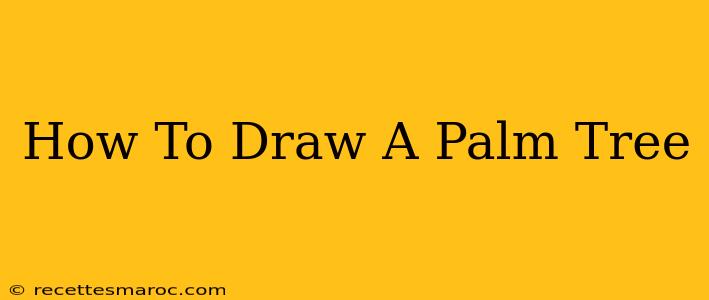So you want to learn how to draw a palm tree? Whether you're a seasoned artist or just starting out, this guide will walk you through the process, from basic shapes to adding realistic details. We'll cover different styles, and help you create your own unique palm tree masterpiece. Let's get started!
Understanding Palm Tree Anatomy
Before we begin drawing, let's take a quick look at the key components of a palm tree:
- Trunk: The thick, sturdy base of the tree. Note its often slightly curved shape and textured surface.
- Fronds: These are the large, feathery leaves at the top of the trunk. Observe how they grow from a central point and often droop gracefully.
- Roots: While often unseen, the roots are crucial for anchoring the palm tree. Consider subtly hinting at them in your drawing, especially if your palm tree is near the ground.
Step-by-Step Guide to Drawing a Simple Palm Tree
This method uses basic shapes to build a foundation, perfect for beginners:
-
The Trunk: Start by drawing a tall, slightly tapered rectangle or a cylinder for the trunk. Don't worry about making it perfectly straight; a slight curve adds character.
-
The Fronds (Crown): Draw a large circle at the top of the trunk. This will be the base of your fronds.
-
Individual Fronds: Divide the circle into sections. From each section, draw long, slightly curved lines that represent individual fronds. Give them a feathery look by adding smaller lines branching off from the main lines.
-
Refining the Details: Add texture to the trunk by drawing vertical lines or slightly irregular shapes to simulate the bark. Refine the fronds, adding more detail and making them look more natural and less uniform.
-
Shading and Highlights: Add depth and dimension to your drawing by shading some areas of the trunk and fronds. Use lighter tones on the parts that receive the most light.
Advanced Techniques for Realistic Palm Tree Drawings
Once you've mastered the basics, you can experiment with more advanced techniques:
Adding Texture and Detail:
- Bark Texture: Use different line weights and shading techniques to create a more textured appearance for the tree trunk. Consider adding small cracks or irregularities.
- Frond Details: Pay attention to how the individual leaflets of each frond curve and overlap. Adding small details will make your palm tree appear more realistic.
- Leaf Variations: Observe the different shapes and sizes of palm fronds. Not all palm trees have the same type of leaves.
Different Palm Tree Styles:
- Coconut Palm: These are characterized by their tall, slender trunks and long, curved fronds.
- Date Palm: These tend to have a thicker, bushier crown.
- Sago Palm: This is a smaller palm with a distinctive, stubby trunk and spiky leaves.
Using Different Media:
Experiment with different drawing tools like pencils, charcoal, or even digital painting software to achieve various effects.
Tips for Mastering Palm Tree Drawings
- Study Real Palm Trees: Look at photos and observe the shapes, textures, and details of real palm trees. This is invaluable for improving your accuracy and realism.
- Practice Makes Perfect: The more you practice, the better you will become at drawing palm trees. Don't be discouraged if your first attempts aren't perfect.
- Experiment with Styles: Try drawing palm trees in different styles, using different techniques and media.
- Have Fun! Drawing should be enjoyable. Relax, and let your creativity flow.
By following these steps and practicing regularly, you’ll soon be able to draw stunning palm trees that capture their unique beauty and grace. Remember to share your creations with others – let your artistic talent shine!

